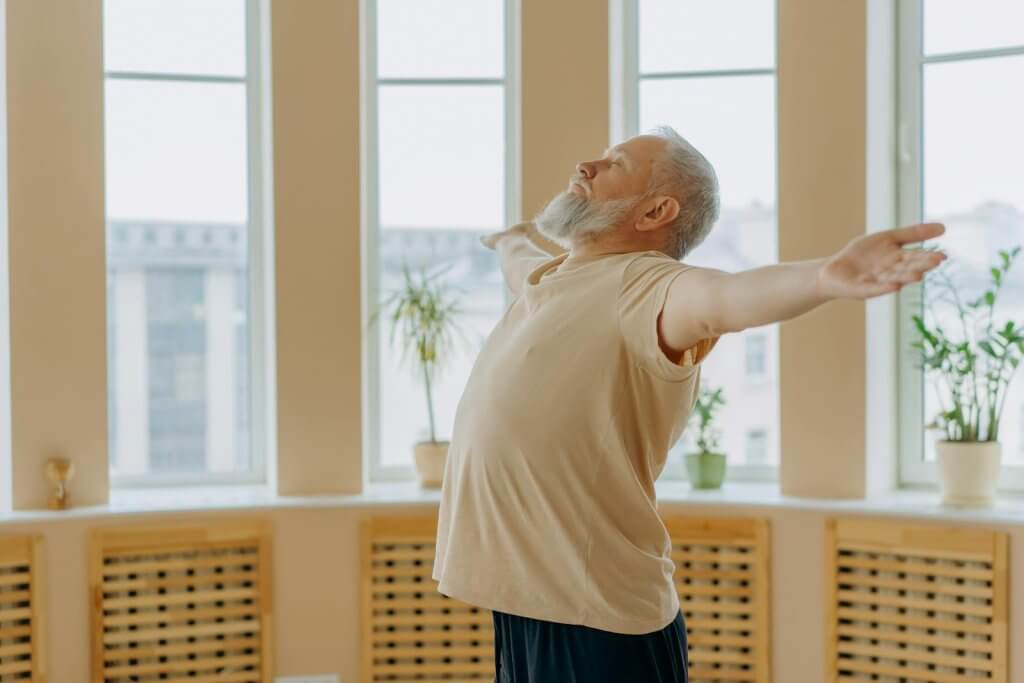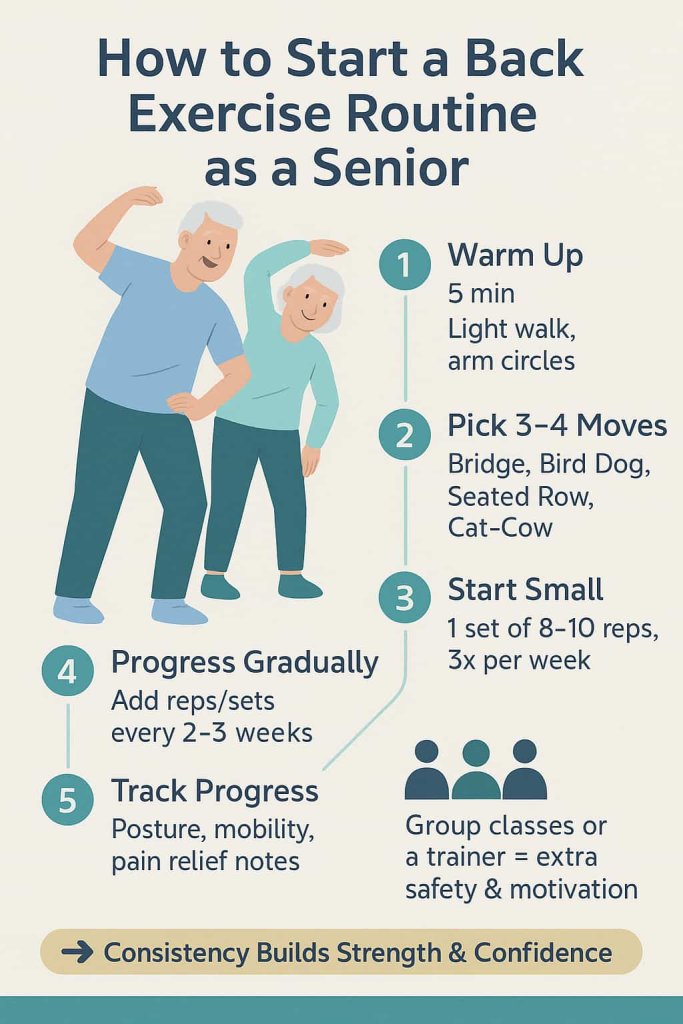Yes, seniors can safely strengthen their back with targeted exercises to ease pain and improve mobility. Building back strength supports posture, reduces the risk of falls, and helps older adults stay active and independent.

Back pain is one of the most common issues among seniors, often caused by weak muscles, poor posture, or age-related changes in the spine. The good news is that research shows strengthening and stretching exercises significantly reduce pain, improve daily function, and boost confidence (Journal of Orthopaedic Surgery & Research, 2023).
In this guide, we’ll cover 13 of the best back strengthening exercises for seniors—safe, effective, and beginner-friendly. Each exercise includes simple instructions, benefits, and safety tips.
Benefits of Back Strengthening for Seniors

- Reduces Pain – Strong muscles support the spine and lower pressure on joints.
- Improves Posture – Corrects slouching and spinal misalignment.
- Boosts Mobility – Makes daily activities like walking, bending, and lifting easier.
- Supports Independence – Builds strength needed for everyday living.
- Prevents Falls – Improves stability by strengthening the core and back.
👉 Harvard Health confirms that consistent stretching and strengthening are key to preventing chronic low back pain (Harvard Health, 2023).
How to Start a Back Exercise Routine as a Senior

Starting slow ensures long-term success and safety. Here’s a step-by-step approach:
- Warm up (5 minutes) – Light walking or arm circles.
- Pick 3–4 beginner moves – Example: Bridge, Bird Dog, Seated Row, Cat-Cow.
- Start small – 1 set of 8–10 reps, 3 times per week.
- Progress gradually – Add more reps/sets every 2–3 weeks.
- Track your progress – Note improvements in mobility, pain levels, and posture.
👉 Group classes or working with a trainer can keep you motivated and ensure proper form.
13 Best Back Strengthening Exercises for Seniors
Maintaining a strong back is key for mobility, posture, and pain prevention as you age. Below are 13 safe, effective, and senior-friendly exercises designed to improve spinal health, reduce stiffness, and boost daily function.
1. Seated Resisted Row
Why it works: Mimics rowing to strengthen mid-back and posture muscles, making sitting and standing easier.
- Muscles worked: Middle back (rhomboids), rear shoulders, arms
- How to do it:
- Sit upright on a sturdy chair.
- Loop a resistance band around your feet.
- Hold the ends and pull back, keeping elbows close to your body.
- Squeeze shoulder blades together, then return slowly.
- Trainer Tip: Keep chest lifted; avoid rounding shoulders forward.
2. Mini Hip Hinge
Why it works: Builds hip and lower back strength safely, teaching proper bending mechanics.
- Muscles worked: Glutes, lower back, hamstrings
- How to do it:
- Stand tall, feet hip-width apart, hands resting on thighs.
- Push hips slightly backward while keeping back straight.
- Return to standing tall.
- Trainer Tip: Keep the movement small and controlled, like a gentle bow.
3. Bridge Exercise
Why it works: Strengthens glutes and spinal support, relieving pressure on the lower back.
- Muscles worked: Glutes, hamstrings, lower back
- How to do it:
- Lie on your back, knees bent, feet flat on the floor.
- Press heels into the floor, lift hips until shoulders–hips–knees form a line.
- Lower slowly.
- Trainer Tip: Focus on squeezing glutes at the top, not arching the lower back.
4. Bird Dog
Why it works: Enhances balance, stability, and coordination while protecting the spine.
- Muscles worked: Core, glutes, lower back
- How to do it:
- Start on hands and knees.
- Extend right arm forward and left leg back.
- Hold for 3–5 seconds, return, then switch sides.
- Trainer Tip: Keep spine neutral—avoid arching or twisting.
5. Cat-Cow Stretch
Why it works: Increases spinal flexibility and relieves stiffness in the back.
- Muscles worked: Spinal extensors, mobility muscles
- How to do it:
- On hands and knees, inhale while arching your back (cow).
- Exhale while rounding your spine and tucking chin (cat).
- Repeat gently 6–10 times.
- Trainer Tip: Move slowly with your breath; don’t rush.
6. Standing Back Extension
Why it works: Builds endurance in the lower back muscles for upright posture.
- Muscles worked: Lower back extensors
- How to do it:
- Stand tall with hands on hips.
- Lean backward slightly and hold for 2–3 seconds.
- Return to upright.
- Trainer Tip: Use a small range of motion—avoid pushing too far.
7. Abdominal Bracing with Leg Extension
Why it works: Strengthens deep core stabilizers that protect the lower back.
- Muscles worked: Core, lumbar stabilizers
- How to do it:
- Lie on your back, knees bent.
- Brace your abs as if preparing for a gentle poke.
- Slowly extend one leg out, then return. Alternate sides.
- Trainer Tip: Keep lower back gently pressed against the floor.
8. Wall Angels
Why it works: Improves posture by strengthening upper back and shoulder stabilizers.
- Muscles worked: Upper back, shoulders, postural muscles
- How to do it:
- Stand with back against the wall, arms bent at 90°.
- Slide arms upward as if making a snow angel, then lower.
- Trainer Tip: Keep your back flat against the wall as much as possible.
9. Side-Lying Leg Lifts
Why it works: Strengthens glutes and side muscles that support the spine.
- Muscles worked: Glute medius, lower back stabilizers
- How to do it:
- Lie on your side, legs straight.
- Lift top leg 8–10 inches, lower with control.
- Switch sides.
- Trainer Tip: Avoid swinging the leg—focus on controlled lifts.
10. Chair Side Bends
Why it works: Strengthens obliques and side stabilizers, reducing risk of falls.
- Muscles worked: Obliques, lateral back muscles
- How to do it:
- Sit tall in a chair, hands on thighs.
- Lean slightly to the right, return, then to the left.
- Trainer Tip: Keep shoulders relaxed, spine long—avoid slumping forward.
11. Marching in Place (Core + Back)
Why it works: Improves balance, coordination, and spinal support for walking.
- Muscles worked: Lower back, core, hip flexors
- How to do it:
- Stand tall and lift one knee slowly, then the other, like marching.
- Continue alternating at a steady pace.
- Trainer Tip: Hold a sturdy chair for balance if needed.
12. Hamstring Stretch
Why it works: Loosens tight hamstrings that can pull on the lower back and cause stiffness.
- Muscles worked: Hamstrings, lower back relief
- How to do it:
- Sit on a chair, extend one leg forward, heel on floor.
- Lean forward gently until a stretch is felt. Hold 20 seconds.
- Switch sides.
- Trainer Tip: Stretch slowly; no bouncing or forcing.
13. Pelvic Tilt (Posterior Pelvic Tilt)
Why it works: Teaches spinal control and gently strengthens deep core muscles.
- Muscles worked: Lower abs, lumbar spine stabilizers
- How to do it:
- Lie on back, knees bent.
- Flatten lower back into the floor by tightening abs.
- Hold 3–5 seconds, relax. Repeat.
- Trainer Tip: Focus on small but precise movements.
Who Should Avoid Back Strengthening Exercises?
Not all seniors should jump right into back workouts. Avoid or modify exercises if you have:
- Severe osteoporosis (fracture risk).
- Recent surgery or back fracture.
- Uncontrolled medical conditions (e.g., severe arthritis flare).
- Sharp or worsening back pain.
👉 Always consult your doctor or physical therapist before starting, especially if you have existing conditions.
Lifestyle Tips to Keep Your Back Healthy
Beyond exercise, healthy habits keep your back pain-free:
- Stay active – Walk, swim, or do yoga regularly.
- Maintain healthy weight – Reduces stress on spine.
- Practice posture – Sit tall, avoid slouching.
- Lift safely – Bend at knees, not waist.
- Sleep smart – Supportive mattress, back/side positions.
- Eat well – Calcium & vitamin D support bone strength.
FAQ: Back Strengthening for Seniors
1. How often should seniors do back exercises?
3–4 times per week is ideal.
2. Can these exercises help with sciatica?
Yes, but consult a doctor if pain is severe.
3. Do I need equipment?
A chair, mat, or resistance band is enough.
4. How long until results show?
4–6 weeks of consistency often brings noticeable changes.
5. Are these safe with osteoporosis?
Yes, but avoid heavy twisting/bending.
6. Should I also walk daily?
Absolutely—walking complements back exercises.
7. Can yoga replace strengthening?
No, but it’s an excellent supplement.
Conclusion
Back strengthening exercises are one of the most effective ways for seniors to ease pain, improve mobility, and maintain independence. By starting with gentle, safe moves and combining them with healthy habits, you can enjoy a stronger, pain-free back.
👉 Start today with 2–3 of the exercises above—your future self will thank you.
